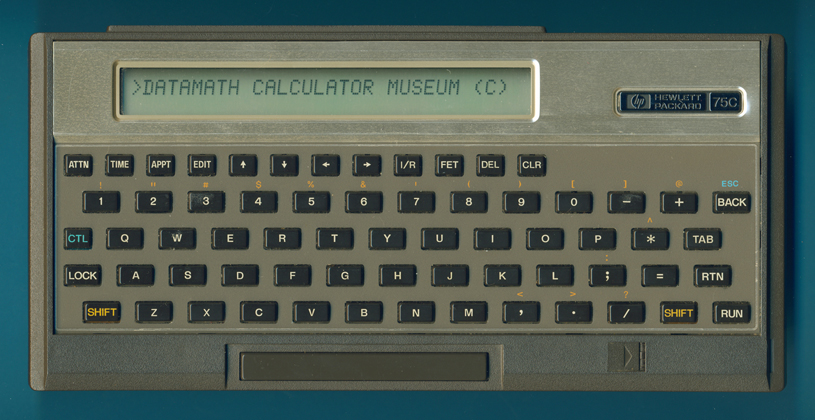
DATAMATH CALCULATOR MUSEUM
 |
DATAMATH CALCULATOR MUSEUM |
Hewlett-Packard HP-75C
| Date of introduction: | September 15, 1982 | Display technology: | LCD dot matrix |
| New price: | $995.00 (SRP 1982) | Display size: | 32 (12 + 2) |
| Size: | 5.1" x 10.1" x
1.3" 129 x 257 x 33 mm3 |
||
| Weight: | 23.6 ounces, 668 grams | Serial No: | 2242A00426 |
| Batteries: | 3*AA NiCd | Date of manufacture: | wk 42 year 1982 |
| AC-Adapter: | HP-82059 | Origin of manufacture: | United States |
| Precision: | 12 | Integrated circuits: | |
| Memories: | 16kB RAM, 48kB ROM | ||
| Program steps: | Courtesy of: | Joerg Woerner |

![]()
 We
assume that Hewlett Packard was as impressed as their main competitor Texas
Instruments, when Matsushita announced in September 1980 in Japan one of the
World's first Hand-Held Computers
and named it accordingly HHC.
We
assume that Hewlett Packard was as impressed as their main competitor Texas
Instruments, when Matsushita announced in September 1980 in Japan one of the
World's first Hand-Held Computers
and named it accordingly HHC.
Hewlett Packard introduced already in July 1979 with the HP-41C an innovative Programmable Pocket Calculator with an alphanumeric LC-Display to overcome the limitations of the first generation products like HP-67 and TI-59, but is was still using simple keystroke programming. While Sharp's PC-1211 and Casio's FX-702P replaced keystroke programmability with a much more powerful BASIC interpreter, introduced the Panasonic HHC System so-called plug-in ROMs (Read-only Memory) not only for user applications but for programming language support, too. Users could chose in 1981 between BASIC or FORTH and develop their target applications accordingly.
The HP-75C introduced about two years after the Panasonic HHC and improved every aspect of the Panasonic RL-H1400 and its stable mates, but lacked the multi-language support:
| Introduction | Product | MSRP | Form | Display | Operation, Programming |
Program Size (Merged?) |
Data Size (Backup?) |
Archive | Ports | Battery | Operating Time |
||||||
| Year | Mth | Company | Model | Size | Techn. | Logic | PGM Mode | Steps | M | Memories | B | ||||||
| 1980 | 9 | Panasonic | RL-H1400 | $500 (1981) | L | 26 | Dot M. LCD | AOS | BASIC FORTH |
4.0k Bytes | RAM | Y | External | 3 | 5*AA NiCd | 100-1,000h | |
| 1982 | 9 | Hewlett Packard | HP-75C | $995 (1982) | L | 32 | Dot M. LCD | AOS | BASIC | 16.0k Bytes | RAM | Y | Mag. Card | 4 | 3*AA NiCd | 100-1,000h | |
Like the Panasonic HHC the HP-75C was the center of a Portable Computer System and it connected through the innovative HP-IL (Hewlett Packard Interface Loop) to a maximum of 30 devices including printers, tape recorders, floppy disc drives, and more. The four integrated ports accepted either up to three additional ROMs or one additional RAM module.
The HP-75D added in 1984 a port for a barcode reader to the HP-75C but it was much less popular than the smaller and more affordable HP-71B introduced in the same year.

 Dismantling
the featured HP-75C with
Date code 2242A
manufactured in October 1982 by Hewlett Packard in the United States reveals a
sandwich construction with two large printed circuit boards (PCBs) centered
around an HP-proprietary 8-bit CPU (Central Processing Unit) on the Main-PCB
supported with various ROM (Read-only Memory) and Display Driver chips. The
second PCB is configured with 8 TC5516AP chips with a capacity of 8n Bytes, each
and manufactured by Toshiba in Japan. The HP-75C is powered by 3 AA-size
rechargeable batteries and a DC/DC converter provides the various voltages for
the main electronics and the display.
Dismantling
the featured HP-75C with
Date code 2242A
manufactured in October 1982 by Hewlett Packard in the United States reveals a
sandwich construction with two large printed circuit boards (PCBs) centered
around an HP-proprietary 8-bit CPU (Central Processing Unit) on the Main-PCB
supported with various ROM (Read-only Memory) and Display Driver chips. The
second PCB is configured with 8 TC5516AP chips with a capacity of 8n Bytes, each
and manufactured by Toshiba in Japan. The HP-75C is powered by 3 AA-size
rechargeable batteries and a DC/DC converter provides the various voltages for
the main electronics and the display.
If you have additions to the above article please email: joerg@datamath.org.
© Joerg Woerner, December 31, 2020. No reprints without written permission.